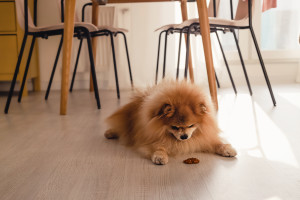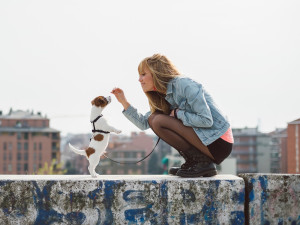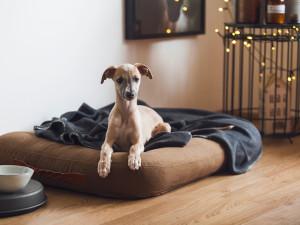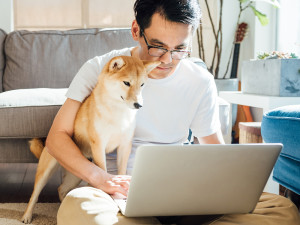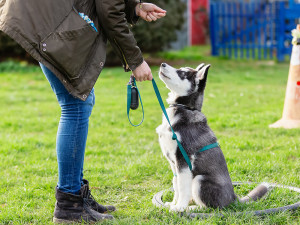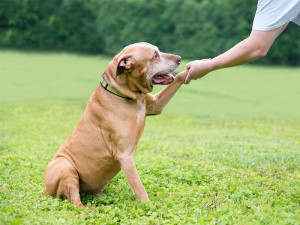How to Teach Your Dog to Shake in a Few Simple Steps
You can help your dog learn this awesome trick.
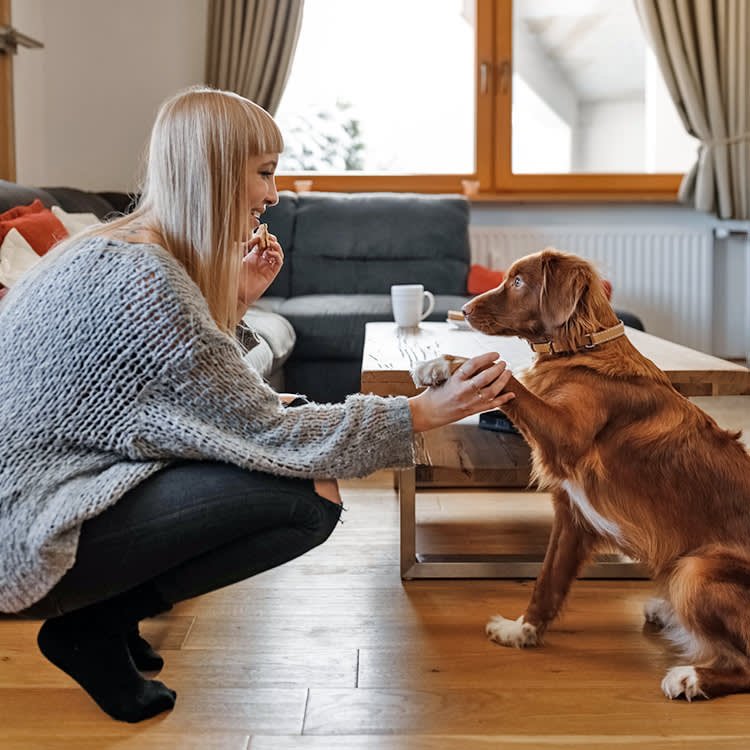
Share Article
In This Article:
Prepare For Trainingopens in a new tab Introduce “Shake”opens in a new tab Keep Practicing Shaking Each Dayopens in a new tab Phase Out the Treatopens in a new tab Switch Hands With the Treatopens in a new tab How to Work With Common Training Setbacksopens in a new tab
Dogs are intelligent, but when it comes to learning new behaviors (such as tricks and commands), they need consistency, patience, confidence, and creativity (to keep training methods interesting) to learn effectively.
According to veterinarian Dr. Alisha Kidwellopens in a new tab, dogs also thrive when their training is tailored to their needs and behavior, and understanding your dog’s body language and unique personality is essential to successful training.

littleKin™ is Kinship’s home just for puppy and kitten parents. Bop over to check out expert advice, new pet tools, and special deals—all curated for your newest family member.
opens in a new tabWe’ll explore these tips and more in this guide to teaching your pup how to shakeopens in a new tab.
Prepare for training
Before teaching your dog to shake, set the stage for a positive, rewarding experience. Structure and repetition are essential, so ensure your training space is quiet and free of distractions, including other people, pets, or loud noises. Gather your dog’s favorite high-quality treats (such as a chunk of cheese or grilled chicken) and prepare to engage your dog’s attention entirely. Training sessions should be short and fun; dogs have short attention spans, so stick with 10- to 15-minute interval training.
Introduce “shake”
1. Have your dog sit while you hold the treat in one hand.
The first step is to get your dog comfortable sitting while you prepare a treat. Sit across from your pup, ensuring they can see the treat in your hand. This creates anticipation and makes them eager to engage.
2. Give your dog the command “shake” and keep your fist under their nose.
While holding the treat, gently but firmly and clearly say, “Shake.” Keep your hand close enough to your dog’s nose so that they can smell the treat. You want them to associate the command with touching your hand with their paw.
3. When your dog touches your hand with their paw, say “good,” and open your hand with the treat.
When your dog touches your hand with their paw, immediately praise them with a cheerful, proud “Good!” and give them the treat. This positive reinforcement is crucial for building obedient behavior.
Keep practicing shaking each day
Consistency is essential to teaching your dog how to shake. While it may be tempting to practice occasionally or “when you have the time,” frequent, short sessions are more effective.
Experts agree that dogs thrive on repetition, and consistent practice will reinforce positive behavior while helping your pup improve their skills. A quick five-to 10-minute session several times daily can significantly and positively impact your pup’s confidence and proficiency.
During practice sessions, maintain a calm, peaceful, and friendly demeanor. Dogs are attuned to your moods and emotions, so remain patient and upbeat. If you're having a bad day, postpone training until you’re in a better mood. Your anxiety and stress could affect your dog’s mood, making them anxious and stressed, too.
Phase out the treat
Once your dog has mastered the “shake” command, reduce the frequency of treats during training sessions. This helps to solidify the behavior, ensuring it isn’t solely dependent on rewards. Instead, shift focus to praise and positive attention. When your dog touches your hand with their paw, give them pets, verbal praise, and other forms of affection to build confidence and encourage continued obedience.
Switch hands with the treat
When your dog has mastered the “shake” command with one hand, switch hands. This step ensures your dog can perform regardless of which side you shake from.
Be consistent in your tone and gestures. Hold the treat as usual and give the “shake” command. As your dog touches your hand, praise them as you would when teaching with the first hand. Shaking with both hands helps strengthen their understanding of the command.
How to work with common training setbacks
No training process is without challenges. Occasionally, your dog may seem distracted or uninterested. Training setbacks can feel frustrating, but your dog is allowed to have an off day. The key is to remain patient and adjust your approach to keep your dog engaged. And sometimes, your pup needs a break.
Adapt your training methods if your dog shows signs of boredom or resistance. New environments, varied tones, and commands can help maintain their attention, reigniting their eagerness and excitement to learn and engage. Another helpful strategy is to break training sessions into shorter intervals. For example, if you’ve been doing 15-minute sessions, try five-minute sessions to give your pup recharge time.
Like humans, dogs can experience burnout, which can make them lethargic, uninterested, and desperately needing a nap (or 12). Allow your dog to rest for a day or two. Engage with them in other ways, like playtime with their favorite toys and belly rubs. A gentler approach will get your dog back on track in no time.
References
“Behaviorism & Dog Training | Introductory Psychology Blog (S14)_C.” Sites.psu.edu, sites.psu.edu/intropsychsp14n3/2014/02/04/behaviorism-dog-training/opens in a new tab.

Valerie Mellema
Valerie Mellema has a Bachelor of Science in Agribusiness and Equine Industry from West Texas A&M University. She has been a professional writer for the past 20 years, covering a wide variety of pet health and care topics before founding a nonprofit focused on mental health in children and thoroughbred aftercare. She has four Border Collies and eight retired racehorses.
Related articles
![Greyhound puppy sitting on her bed on the bedroom floor]() opens in a new tab
opens in a new tabUse Platform Dog Training to Elevate Your Pup’s Skills
Using platforms are favorites with pro dog trainers—here’s why you should add them to your training to-do list.
![A dark-haired man using a laptop to train his Shiba Inu online]() opens in a new tab
opens in a new tabHow Online Training Supports Dog Owners and Dog Trainers
The virtual dog-training revolution is here.
![A red haired woman dog trainer kneeling in front of a Shepherd mixed breed dog with one finger raised that the dog is looking at in an outdoor training course.]() opens in a new tab
opens in a new tabUnderstanding Popular Dog Training Methods
Look behind the advertising language when picking a dog trainer.
![Woman trains with a young husky on a dog training field]() opens in a new tab
opens in a new tabHow to Find a Qualified Trainer for Your New Dog
The questions to ask and credentials to look out for to find the right trainer for your dog, according to a pro.
![A senior Retriever/Terrier mixed breed dog shaking hands with its owner.]() opens in a new tab
opens in a new tabHow to Teach an Old Dog New Tricks
Your senior dog might move slower these days, but that doesn’t mean they can’t learn new things.
![Boston terrier being stubborn]() opens in a new tab
opens in a new tabDog Training — DIY or Hire a Pro?
When it’s time to call in reinforcements.
